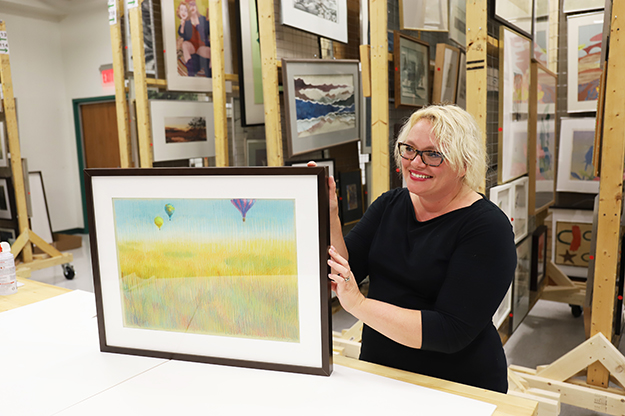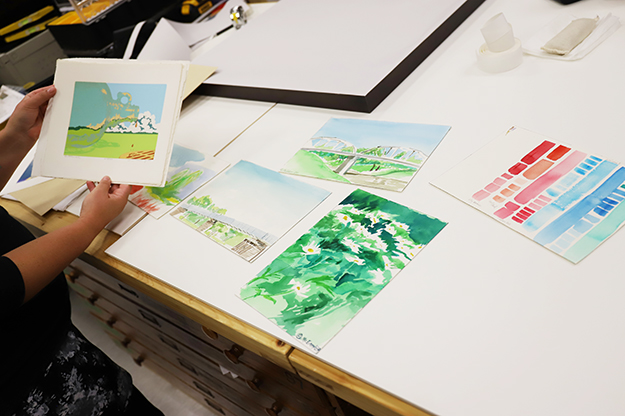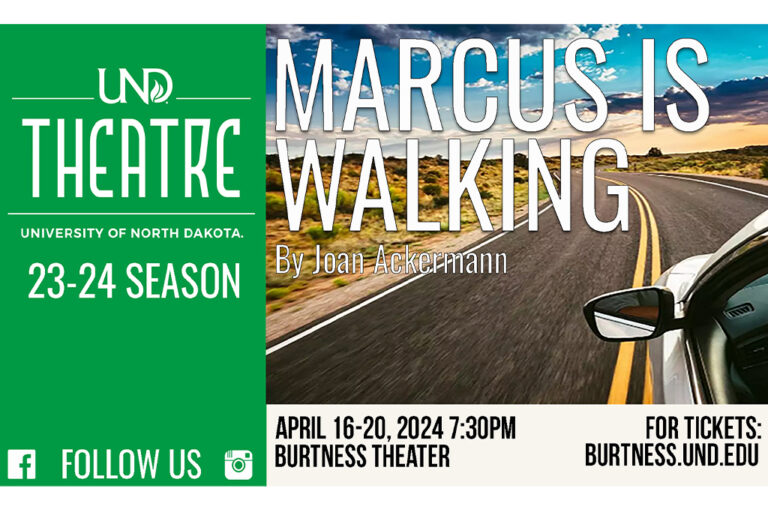Brought into frame
UND Art Collections to exhibit works by former faculty member Jackie McElroy-Edwards in downtown gallery

“Art doesn’t hang itself,” Wesley Rabey said, as he drilled holes into an otherwise complete frame.
The new UND Art Collections hub in the Scalicky Tech Incubator is a menagerie of art, power tools and the makings of a brand new exhibit – its debut mere weeks away.
Land Escape: A Collection of Works on Paper by Jackie McElroy-Edwards opens Monday (Sept. 24) and runs through Jan. 11, 2019, at the Empire Arts Center in downtown Grand Forks. The Monday opening starts with a free public reception from 4:30 – 7 p.m.
“It feels like it’s going smoothly,” Sarah Heitkamp remarks. “We install a week from today, but we’re right on schedule.”
Heitkamp, recently appointed to manager and curator of UND Art Collections, sorts through a pile of frames she assembled. Each of the 25 pieces have a custom-sized frame. Aside from that, the pair cut and constructed everything on-site.
Well, not including the artwork the frames contain.
Jackie McElroy-Edwards taught for over 30 years (1968-2000) as a screen printer and art historian, also chairing the art department during her tenure. Throughout the end of the 20th century, she crafted prints, pastels and watercolors, over 200 of which are kept at UND. Her art graced regional galleries and national juried shows.
When the Empire Arts Center opened in 1998, she was a member of its Executive Committee and Building Committee. Current Executive Director Emily Montgomery says that McElroy-Edwards was also the Empire’s first board president.
After retiring, McElroy-Edwards and her husband, Tom, moved to Phoenix, Ariz. in 2014. It was then the couple decided to pass part of Jackie’s collection to the University. Rabey, a facilities technician for the Hughes Fine Arts Center, went to their home to retrieve it.
“A lot of it was in their basement,” Rabey recalled. “She was sweet; she made it seem like we were helping her out by moving it out of the house.
“Working with it now, I’m in awe of the simplistic yet complex appearance – the combinations of colors in her work amaze me.”

Combining favorites
Before her appointment to manager and curator, Heitkamp worked with the department to catalogue every piece in the University’s possession. She says they’ve digitally documented 8,000 works, accessible through Scholarly Commons.
“When you’re going through pieces one at a time, you start to get to know some artists you’re examining,” Heitkamp told UND Today. “Fortunately I’ve had great student employees working with me, and one artist that they always come back to as their favorite is Jackie McElroy-Edwards.
“When I was asked if I would curate this exhibition, I knew right away this would be an opportunity to work with students to bring our favorites together.”
McElroy-Edwards, herself, considers her work to be regionalist with a small “r.” In an artist statement on the North Dakota Art Gallery Association website, McElroy-Edwards said her work is about place. Many pieces in both color and shape immediately connect with the Red River Valley and North Dakota, which she juxtaposes with surreal objects or positions of objects more common to the setting – such as grain elevators.
Alyssa Borka is one of the students working with Heitkamp this semester. While the framing and drilling was happening on one side of the room, she was at the computer making labels to keep finished works organized.
“I’m not an art student at all,” the psychology sophomore said. “I don’t think I’ve ever had a favorite artist before, but I had to go home and look her up. She’s become my favorite out of all of the works I’ve handled.”
An owner of McElroy-Edwards’ art, Thomasine Heitkamp is a professor in the UND College of Nursing & Professional Disciplines.
“Her art provides a backdrop for all who love North Dakota,” she said. “Her stunning and wonderful landscapes bring our state to life. I have her full North Dakota suite — four pieces beginning in the Red River Valley and ending in the Badlands — in my dining room. I enjoy it every day.”
Retired events coordinator Dawn Botsford expressed how fortunate she was to take a class — art appreciation — taught by McElroy-Edwards. She also has one of the artist’s pieces in her home.
“She was a great teacher, a great artist and I learned a great deal from her,” Botsford said. “The University’s requirement that students take a humanities course, which included art appreciation, gave me an understanding of how important art and art history is to our lives.”

Certain rarities
As Heitkamp sorts through a table stacked with wrapped artwork, she pulls a smaller selection from the fray. She says that while McElroy-Edwards was most known for her vivid screen prints, her watercolors and sketches are truly one-of-a-kind.
“With some of these, I wonder who has seen them besides us,” Heitkamp said.
Rabey replies that he doesn’t remember seeing any of them in particular. When retrieving them, they were taken in stacks. Visitors to the exhibit will be able to see them in a display case alongside the larger, framed works.
Heitkamp points out that some of them are studies that show the artist’s process – mixing colors, playing with light and negative space.
“They’re interesting because you don’t see that side of artists, their private watercolor padfolios,” she said. “They don’t usually put it out for everyone to see. It’s going to be fun to show those along with her known works.”



